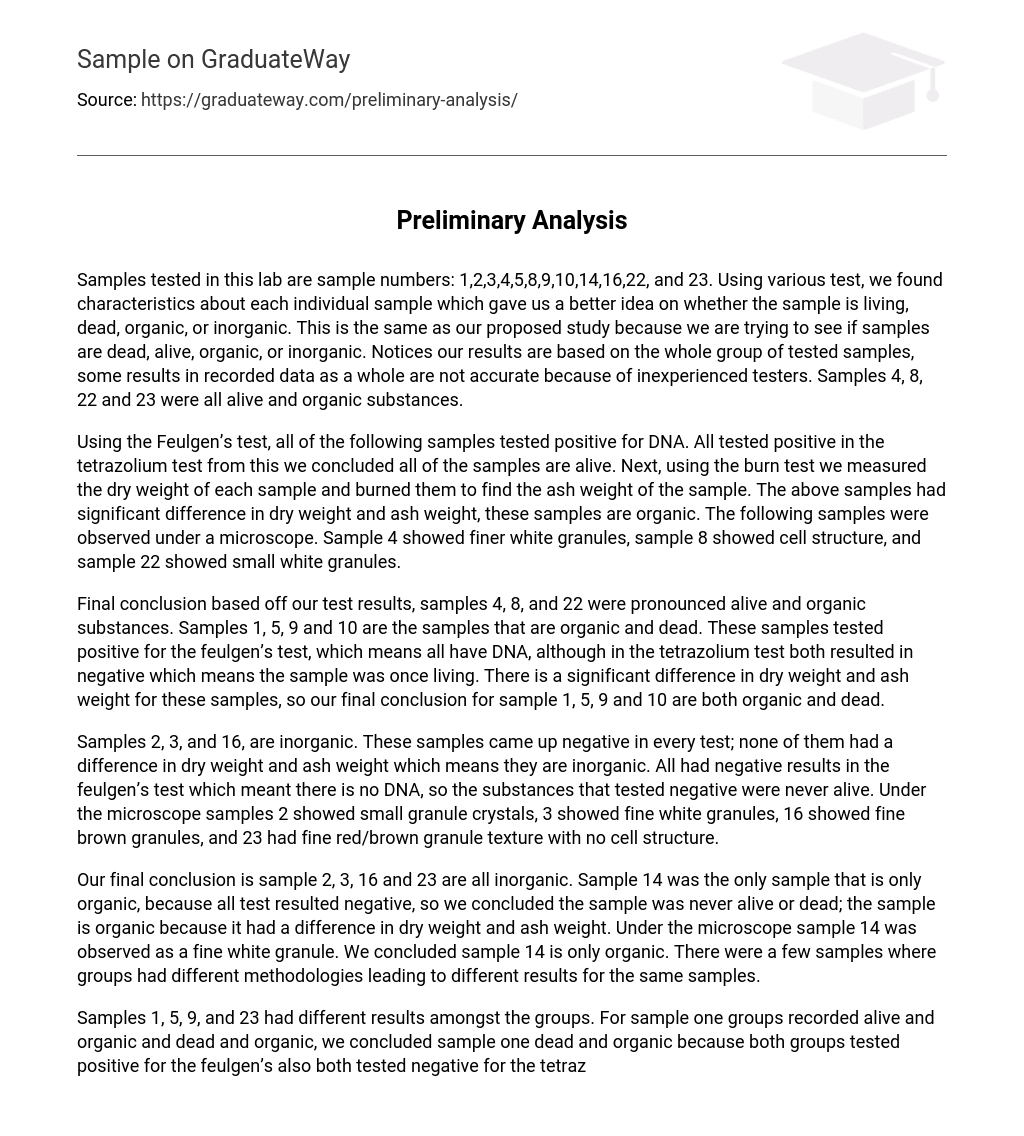Samples tested in this lab are sample numbers: 1,2,3,4,5,8,9,10,14,16,22, and 23. Using various test, we found characteristics about each individual sample which gave us a better idea on whether the sample is living, dead, organic, or inorganic. This is the same as our proposed study because we are trying to see if samples are dead, alive, organic, or inorganic. Notices our results are based on the whole group of tested samples, some results in recorded data as a whole are not accurate because of inexperienced testers. Samples 4, 8, 22 and 23 were all alive and organic substances.
Using the Feulgen’s test, all of the following samples tested positive for DNA. All tested positive in the tetrazolium test from this we concluded all of the samples are alive. Next, using the burn test we measured the dry weight of each sample and burned them to find the ash weight of the sample. The above samples had significant difference in dry weight and ash weight, these samples are organic. The following samples were observed under a microscope. Sample 4 showed finer white granules, sample 8 showed cell structure, and sample 22 showed small white granules.
Final conclusion based off our test results, samples 4, 8, and 22 were pronounced alive and organic substances. Samples 1, 5, 9 and 10 are the samples that are organic and dead. These samples tested positive for the feulgen’s test, which means all have DNA, although in the tetrazolium test both resulted in negative which means the sample was once living. There is a significant difference in dry weight and ash weight for these samples, so our final conclusion for sample 1, 5, 9 and 10 are both organic and dead.
Samples 2, 3, and 16, are inorganic. These samples came up negative in every test; none of them had a difference in dry weight and ash weight which means they are inorganic. All had negative results in the feulgen’s test which meant there is no DNA, so the substances that tested negative were never alive. Under the microscope samples 2 showed small granule crystals, 3 showed fine white granules, 16 showed fine brown granules, and 23 had fine red/brown granule texture with no cell structure.
Our final conclusion is sample 2, 3, 16 and 23 are all inorganic. Sample 14 was the only sample that is only organic, because all test resulted negative, so we concluded the sample was never alive or dead; the sample is organic because it had a difference in dry weight and ash weight. Under the microscope sample 14 was observed as a fine white granule. We concluded sample 14 is only organic. There were a few samples where groups had different methodologies leading to different results for the same samples.
Samples 1, 5, 9, and 23 had different results amongst the groups. For sample one groups recorded alive and organic and dead and organic, we concluded sample one dead and organic because both groups tested positive for the feulgen’s also both tested negative for the tetrazolium test. Groups recorded sample 5 organic and dead, and organic and alive, both groups have different test performed for sample 5, so we concluded based off both groups results organic and dead because both groups recorded a negative result for the tetrazolium test.
Sample 9 groups recorded organic and alive, and organic and dead. We concluded sample 9 organic and dead because both groups tested negative for the tetrazolium test. Sample 23 groups recorded dead and inorganic, and alive and organic, we concluded this sample is alive and organic because sample 23 tested positive for all test in one group and the other group have lack of supporting data to back up there conclusion.





